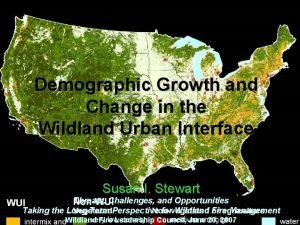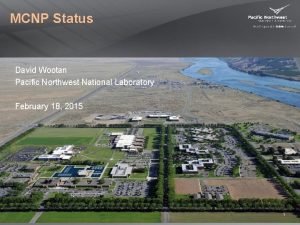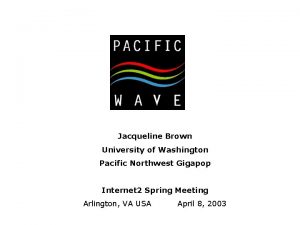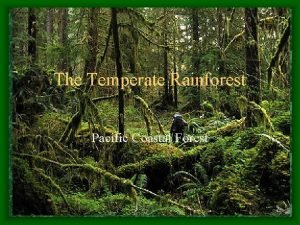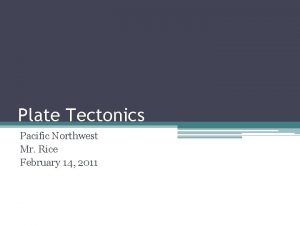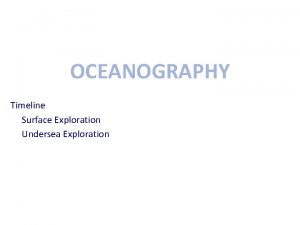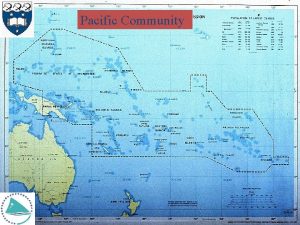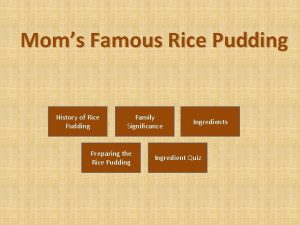EXPLORATION OF THE PACIFIC NORTHWEST Mr Rice Pacific















- Slides: 15

EXPLORATION OF THE PACIFIC NORTHWEST Mr. Rice Pacific Northwest History April 5, 2011

THE FIRST VISITORS The first non-Indians to the area probably came from either China or Japan. More than likely they were blown off course and came to rest on North America. Chinese documents tell of Hui San, a Buddhist monk, who probably sailed to the Pacific Coast in the year 499. None of the groups established permanent settlements.

KEEP IN MIND… One of the largest driving forces for exploration was the search for a Northwest Passage. It was a route that would save time, money and held the possibility of finding new lands. Explorers were highly funded by European royalty to find this passage. elusive

SPANISH EXPLORERS The Spanish may have been the first to purposefully sail ships along the Pacific Coast. Juan de Fuca claimed in 1598 that Spain had hired him to sail in the Pacific and that he had found a wide strait. European mapmakers began calling this area the Strait of Juan de Fuca. 180 years later Juan Perez sailed to Alaska and claimed the territory for Spain. Finally, in 1775 Bruno de Hezeta claimed the coast of modern day Washington for Spain.

WHY DIDN’T SPAIN SETTLE THE NORTHWEST? 1. Spanish crews were very busy harvesting pearls off the western coast of Mexico and California. 2. There was no surface mineral wealth- no gold or silver to be harvested. 3. There were no large populations to enslaves. 4. The coastline was steep and rugged and made easy development very difficult.

JAMES COOK AND THE BRITISH An experienced explorer, Cook had already been around the world twice, in both directions. He sailed on two ships, the Resolution and the Discovery in 1776. Seeing the Spanish already at Nootka Sound, (modern day Vancouver Island) Cooks crew gave up and traded trinkets for warm Sea Otter pelts that worked great for clothes and bedding in the poor climate.

SOFT GOLD CHANGES THE WORLD!!! Eventually Cook sailed back to the Sandwich Islands (Hawaiian Islands) and was killed by natives. His crew sailed to China where they were delighted to find the Chinese paid high prices for otter pelts. While Cook failed, his efforts spawned the lucrative fur trade and so brought the first European settlements to Washington.

DOWNFALL OF THE SEA OTTER Between 1750 and 1790 thousands of sea otters were killed for their furs. Almost all of the otters were taken by explorers and trappers before beaver trapping really got underway. Why the need? Chinese people used the furs for blankets and coats during the bitter winters. The trade of otter furs only stopped when their were not enough otters to make the trips to get them worthwhile. In 1977, the U. S Fish and Wildlife Service placed the sea otter on the Endangered species list.

NOOTKA SOUND CONTROVERSY Spain feared America’s efforts to find western seaports, so in an effort to protect it’s interests, it built Fort San Miguel. Eventually, the Spanish, British, Americans and Russians all wanted to profit from the fur trade. Since both Spain and Britain had claimed Nootka Sound, George Washington feared being pulled into a war by Britain. Eventually, Spain ceded and Britain took complete control of the Oregon Country.

ROBERT GRAY In 1792, after hearing of the profits from fur trading, Gray left Boston for the Pacific Ocean. Once he and his crew reached the Pacific they discovered what seemed to be a large river, but could not enter into it. Because of this they sailed on to a large inlet “which had the very good appearance of a harbor. ” (Gray’s Harbor!!!!) Later they would go back and make it into the river, naming it the Columbia and claiming it

AMERICAN FUR TRADERS The Pacific Fur Company, started by John Jacob Astor, built Fort Astoria to control the Columbia River for the United States. They struggled through many great ordeals and eventually firmly established America’s “ownership” of the coast of Oregon. They traded with Indians in the region, took furs to China, , bought Chinese silk, spices, and rugs and then sailed to New York to sell them.

THE HUDSON’S BAY COMPANY In 1821, the British Hudson’s bay company controlled the majority of the fur trade in Canada and the Oregon Country. The HBC chose Dr. John Mc. Loughlin to head their Oregon Country division. Mc. Loughlin built a new fort at the mouth of the Willamette and called it Fort Vancouver. The fort contained a hospital, a dairy, herds of cattle, a sawmill and a gristmill to grind grain. Fort Vancouver was a trading post, not a military fort. It was the main source of supplies and information for early trappers, missionaries, and settlers.

VOYAGEURS Traders used canoes to move up and down the rivers. The men who paddled the canoes were French-speaking Canadians called voyageurs. The voyageurs became famous for their strength, their dress, and they sang the colorful the songs paddling down rivers.

FURS, FORTS AND FARMS The main purpose of the forts was trading furs. Trappers killed animals for their furs, while Indians brought furs to trade for glass beads, muskets and metal objects. By this time, around the 1830’s, beaver pelts – called a plew – was in high demands for hats. By the time silk hats replaced beaver hats, the beaver in the Pacific Northwest was nearly extinct. The HBC set up farming operations to supply it’s trappers and traders with necessary products.

THE FUR TRADE ENDS By the late 1840’s the fur era was over. All of the fur-bearing animals in the Pacific Northwest were gone. Pioneers were now beginning to move into the area and used the of the forts and help them the frontier help trappers to get along in territory.
 Intermix
Intermix Pacific northwest serial killers
Pacific northwest serial killers Pacific northwest college credit
Pacific northwest college credit Raven: a trickster tale from the pacific northwest
Raven: a trickster tale from the pacific northwest Pacific northwest national laboratory
Pacific northwest national laboratory Pacific northwest gigapop
Pacific northwest gigapop Pacific northwest smart grid demonstration project
Pacific northwest smart grid demonstration project Pacific temperate rainforest map
Pacific temperate rainforest map Pacific northwest food
Pacific northwest food Thiếu nhi thế giới liên hoan
Thiếu nhi thế giới liên hoan Sự nuôi và dạy con của hổ
Sự nuôi và dạy con của hổ điện thế nghỉ
điện thế nghỉ Thế nào là sự mỏi cơ
Thế nào là sự mỏi cơ Một số thể thơ truyền thống
Một số thể thơ truyền thống Trời xanh đây là của chúng ta thể thơ
Trời xanh đây là của chúng ta thể thơ Các số nguyên tố là gì
Các số nguyên tố là gì
